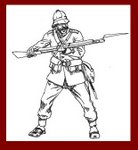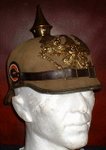| Native Firepower in the Desert Firearms in use in southeast Morocco The firearms traditionally in use by the Arab and Berber tribes of Southeastern Morocco were flintlock muskets if the style that had been in use since the 17th century. Mostly Jewish gunsmiths who resided in the kasars of the Tafilalt and Figuig regions in South Eastern Morocco manufactured them. They were made of good quality iron transported from the north along the caravan routes and were often highly ornate and of good quality. These locally manufactured weapons supplemented the considerable numbers of European muskets imported to Morocco throughout the 18th and 19th centuries. This influx of flintlock firearms increased rapidly in the mid nineteenth century as huge numbers of surplus military flintlocks became available when European armies made the transition to percussion rifles. Percussion rifles never gained the respect of the Arabs due to the difficulty of obtaining percussion caps, which they were unable to manufacture locally. Issued with the Chassepot rifle in 1866,the French had their first breech-loading rifle. It was particularly notable for its consumable cartridge. This was an odd choice considering the availability of several metallic cartridges. It was, however considerably superior to its main contemporary counterpart, the Prussian needle gun. There was a shortage of available Chassepots for the French army and they were supplemented with 1866 Remington rolling block breech loading rifles purchased from the United States. Thousands of these Remington rifles found themselves in Africa in the 1860's and 70's. As was the case throughout Africa, the introduction of new weaponry led to a flood of replaced obsolescent weapons appearing in the hands of the indigenous populations. The introduction of the French Gras rifle and carbine in 1874 and the British Martini Henry in 1871 resulted in large numbers of their predecessors, the Remington (and to a lesser extent, the Chassepot) and the British Snider Rifle being issued to trained native armies in Africa. The new rifles differed in that they were dedicated purpose built metallic cartridge breech-loaders as opposed to conversions of earlier muzzleloaders. Although a few numbers of Snider, and eventually Martini Henry Rifles made their way to the Arab tribes of Morocco, it was the Remington that showed up in the largest numbers. The Sultan of Morocco, Mawlay Hassan, along with his successors purchased thousands of these rifles from the Europeans. These eventually filtered across the Atlas Mountains to the Desert fringe tribes, many of which were armed by the Sultan as auxiliaries to the Makhzan (Moroccan government). These auxiliaries usually kept the rifles with which they were issued or sold them to neighboring tribes. This natural supply was significantly augmented by Spanish and British gun runners against whom the Makhzan were notably ineffectual. The Gras stayed in service with the French until 1885 when the Lebel replaced it, and the British similarly progressed from the Martini Henry in 1888. The magazine fed 9 shot Lebel rifle was a significant change for the French. It was built around the French invention of the new smokeless powder and contained a tubular magazine running below and along the length of the barrel. The smokeless powder had the obvious advantages in that clouds of thick white smoke during combat did not obscure the enemy. The other notable and often overlooked advantage of this smaller caliber is the hugely greater grazing zone. It did not take the military powers throughout Europe to realize the advantages of this. With its flatter trajectory, the path at which the bullet travels at the height of a man is much greater that with the more pronounced parabolic trajectory of the slower larger caliber bullets of the preceding rifles. This meant that at greater ranges, the bullet did not rise above head height reducing the element of error previously encountered with inaccurate estimating of ranges. The Lebel was only used by the Arabs in limited numbers and the only way they usually fell into their hands was through successful ambushes and the raiding of supply trains. The other problem was that the Arabs had no way to reload the cartridges as smokeless powder was beyond their manufacturing capabilities. Black powder was imported, but the Arabs also had the ability to manufacture it locally. They reloaded the empty cases, with locally made bullets and made percussive primers out of smuggled gasoline and powdered match heads. These were undoubtedly inferior to European factory ammunition but sufficed when it was not available. By the 1880's there was no real reason for a warrior to continue to carry a flintlock riffle unless he wanted to. At the turn of the century the Remingtons and other breach loading rifles and a few repeaters were available in huge numbers despite the fact that selling anything to the Arabs other than flintlocks was forbidden by the French in Algeria. A magazine fed rifle that did make its way to Morocco in notable numbers was the Winchester repeating rifle. This American firearm was easy for the Arabs to reload for. A French study of firearms in the frontier region produced the following results in 1894 concluding that the Remington model rifle was the most available rifle in the region. | 































No comments:
Post a Comment